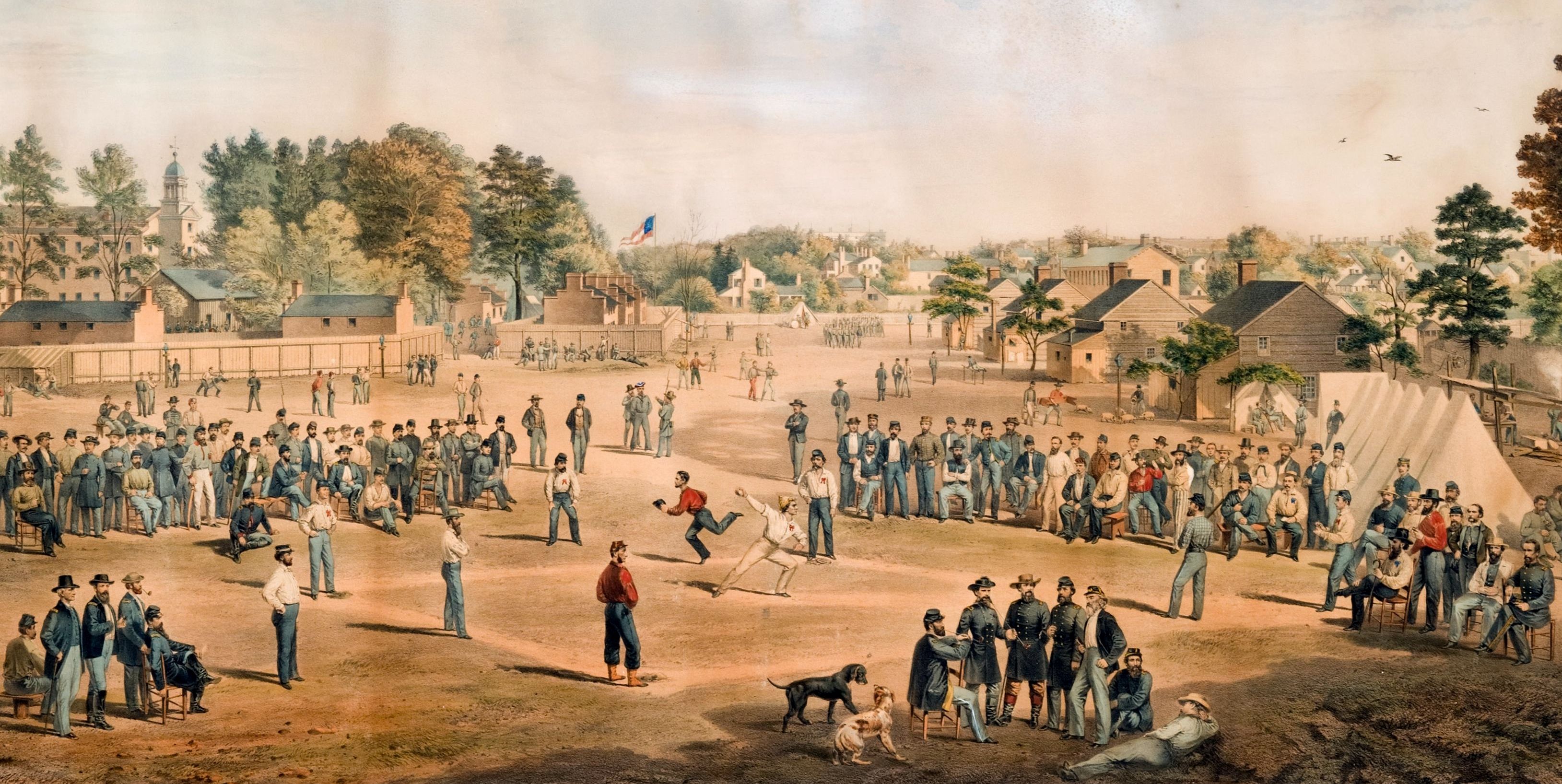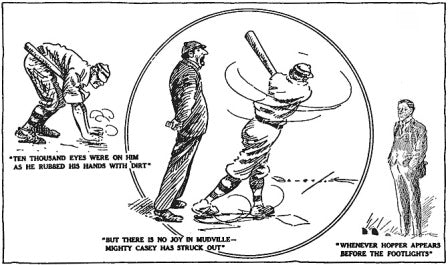Albert Goodwill Spalding
Star pitcher of the 1870's, team owner, promoter, and entrepreneur--Albert Goodwill Spalding's name is still attached to the sporting goods empire he created. Spalding also became baseball's first true chronicler and historian. Whether Spalding was reflecting upon the epic contests of the ancient past, or evoking his personal experiences on the baseball diamonds of the 1870's, his epigram adroitly captured "Casey's" place within American culture.

Albert Spalding
Boston Red Stockings baseball card, 1871 (public domain). Spalding, inducted into the Baseball Hall of Fame in 1939, was a star pitcher of the 1870's.

Ernest Thayer
Portrait of Ernest Thayer (1863-1940) as a young man, from the A. G. Spalding Baseball Collection (public domain).

Thirteen Decades Later
Thirteen decades after "Casey at the Bat" first appeared in the San Francisco Examiner, it's time to take a fresh look at the poem subtitled by its creator "A Ballad of the Republic, Sung in the Year 1888." In this blog, we'll also explore a lot more about the author, Ernest Lawrence Thayer--an unassuming yet brilliant young man with an understated, self-deprecating sense of humor. And we'll learn much more about Thayer's friends and classmates at Harvard from 1881 to 1885-- especially the future media mogul William Randolph Hearst, the budding philosopher George Santayana, and the young man titled by Ernest "a born leader''--captain of the stellar 1885 Harvard baseball team--Samuel Ellsworth Winslow.

Biography of a Poem
Caseyatthe.blog tells the story of a poem--a poem far more familiar to the American public than the man who wrote it. The story of the poem's origins, and the acclaim and controversy which trailed its course, now reveal more than we have ever known about its author. Likewise, emerging details of Ernest Thayer's life now enable us to read the "Ballad of the Republic"-- as it was enigmatically subtitled--with a deeper understanding of the historic and literary context within which "Casey at the Bat" was crafted. And we will learn of Thayer's youthful struggle which not only inspired the poem, but provided its surprising, enduring twist.

Authorship and Its Defense
"Casey at the Bat" quickly catapulted its protagonist into the ranks of American folk heroes--while its diffident author, when he became known, only sought to downplay his achievement and to obfuscate the poem's origins. Taking advantage of the author's near-anonymity, various notables and would-be poets attempted, even decades after "Casey's" first appearance, to claim authorship. Reluctantly at first, then angrily, Thayer was compelled to rise to the defense of his work --employing not only the comradeship of his Harvard pals but also the professional services of his friend and attorney, '85 classmate Eugene Lent--as well as the stealthy intervention of the Pinkerton Agency.

A Ballad of the (Roman) Republic
Woven into the "Casey's" origin is a brilliant misprision of the nineteenth century's most popular heroic ballad. Call it a parody if you like, but Yale Professor Harold Bloom has resurrected the Elizabethan misprision to characterize a deliberate, creative misreading of a predecessor text. Casey's" twentieth-century readers were so enthralled by the drama enacted on the baseball field that they missed what Thayer's classmates and other contemporaries clearly grasped: Thayer had taken the ancient Roman ballad of Horatius' defense of Rome against Etruscan invaders, and turned it on its head.
In his retelling of Thomas Macaulay's 1842 "Horatius at the Bridge," as the British historian's poem became known in America, Thayer showed his unique appreciation of the "broken edges of things"--an idiosyncrasy Santayana claimed to share. Though Americans readily embraced the ballad's protagonist, in an ironic inversion which no doubt amused "Casey's" creator, they found it hard to accept the sublime tragedy which had brought low the mighty slugger and his legions of Mudville fans
Love, War, and Tragedy
And what of Love, War, and Tragedy--the fateful triad evoked by the erudite Albert Spalding? Each one of "Casey's" themes plunges an oar into the currents propelling the poem's narrative--especially the whitewater cascades navigated by Ernest Thayer in the fateful years of 1887 and 1888 when "Casey" was conceived and written.
From the beginning, “Casey at the Bat” was appreciated although misapprehended as baseball's first--perhaps its only--epic. But in the meantime "Casey" had artfully reintroduced tragedy as interpreted by the Athenian playwrights to an American people believing themselves immune to the calamities of the ancients. Galloping through their Gilded Age, Americans had little time for somber reflection—not even in the shadow of a tragic Civil War.

There is no chance in Cambridge…
By their own account, the generation born during the war, but too young to remember it--like Thayer and his classmates--still felt the shadow cast by the War--and by the memory of the heroes who perished in it.
These children of the Gilded Age resented the burden of memory imposed on the living by legions of the fallen. Thayer, Santana, and the others of their generation felt themselves overshadowed by the War and its legacy of heroic deeds.
"Our own beaux jours were not very beautiful. I am not sure that the war wasn't a sort of Deluge providentially destined to drown our generation. We were genteel, we were aesthetic, but we were impotent," wrote George Santayana in 1922.
Thayer also would explore this theme in several of his later newspaper ballads, but most memorably in his Ivy Day oration to the Class of 1885: "There is no chance in Cambridge for the young man of heroic intentions."
George Santayana
Front row left, and the Mermaid Club at Harvard (courtesy Harvard University Archives).

The great bristling brick Valhalla
"The great bristling brick Valhalla," wrote Henry James, dispensed "laurels to the dead and dinners to the living." Harvard's Memorial Hall, designed by alumni Henry Van Brunt and William Robert Ware, was completed in 1878 to honor students who had died in the Civil War..
The four-faced clock was destroyed by fire in 1956. (Photographer unknown)
Heroes of a New Era
Ernest Thayer and his classmates Sam Winslow, George Santayana, and William Randolph Hearst longed for opportunities to become heroes of a new era. Whether in the lecture halls and libraries of peacetime scholarship, on the floors of legislative chambers and political conventions, or on grassy fields bounded by lines of chalk, their own aspirations would demand expression. Meanwhile, Theodore Roosevelt, Henry Cabot Lodge, and others too young to have fought their fathers’ war lusted for the ennobling glories which they believed a future conflict would provide.

Samuel Ellsworth Winslow (1862-1940)
Thayer's boyhood friend and classmate at Harvard. As manager / player, Winslow captained the 1885 Harvard Base Ball team to an unparalleled record of 27-1. Often mentioned by Thayer in connection with "Casey at the Bat," was Winslow the inspiration for the poem?
(Photo courtesy of Harvard University Archives)

Caseyatthe.blog will tell these stories and many more.
It's my belief that Thayer's "Ballad of the Republic"--in a way that until now we have not understood--is the anthem of an era still striking chords of familiarity with our own.
Our Articles

Ballad of the Republic: The Arming of the Man
The poem "Casey at the Bat" captures the American spirit, the drama of Whitman's "hurrah game of the Republic," and the rough-hewn spectacle of the years when crowds cheered from wooden bleachers f...
Read more
Casey at the Bat: The Controversy (Part 1)
Following is the first of two posts in his Our Game blog by John Thorn, Official Historian of Major League Baseball, focusing on the authorship challenges that vexed Ernest Thayer for decades after...
Read more
The Love Song of E. "Phineas" Thayer
The Love Song of E. "Phineas" Thayer was awarded Honorable Mention in the Print/Online Article category of the 89th Annual Writer's Digest Writing Competition in August, 2020. The awarded vers...
Read more


